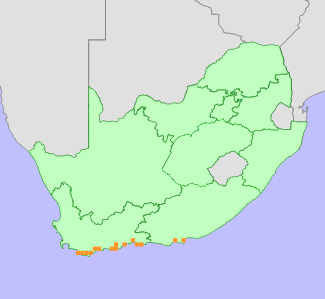|
Scientific Name | Lebeckia gracilis Eckl. & Zeyh. |
Higher Classification | Dicotyledons |
Family | FABACEAE |
National Status |
Status and Criteria | Endangered A2bc; B1ab(ii,iii,iv,v) |
Assessment Date | 2020/11/03 |
Assessor(s) | D. Raimondo & M.M. le Roux |
Justification | A population reduction of at least 70% is estimated based on habitat loss to agriculture, forestry plantations, alien plant invasion and coastal development in the past 120 years (generation length 50-80 years), resulting in local extinctions at 73% of known locations. Only between two and five locations within an EOO of 4000 km² are likely to remain, and these continue to decline due to ongoing habitat loss. It is therefore assessed as Endangered under criteria A and B. |
Distribution |
Endemism | South African endemic |
Provincial distribution | Eastern Cape, Western Cape |
Range | It is endemic to the Western and Eastern Cape provinces of South Africa, where it occurs from Bredasdorp to Port Elizabeth. |
Habitat and Ecology |
Major system | Terrestrial |
Major habitats | Groot Brak Dune Strandveld, Overberg Dune Strandveld, Kouga Grassy Sandstone Fynbos, Albertinia Sand Fynbos, Agulhas Sand Fynbos, Southern Cape Dune Fynbos, Knysna Sand Fynbos, St Francis Dune Thicket, Hartenbos Dune Thicket, Goukamma Dune Thicket |
Description | This species inhabits coastal fynbos, renosterveld and strandveld in deep, sandy soil below 300 m. This is a long-lived resprouter with a generation length of 50-80 years. |
Threats |
| Coastal development is a severe past and ongoing threat throughout this species' range. Afforestation was a severe past threat between Wilderness and Plettenberg Bay. Agriculture was a severe past threat, especially around Albertinia. |
Population |
Population trend | Decreasing |
Assessment History |
Taxon assessed |
Status and Criteria |
Citation/Red List version | | Lebeckia gracilis Eckl. & Zeyh. | EN A2bc; B1ab(ii,iii,iv,v) | Raimondo et al. (2009) | |
Bibliography |
Manning, J.C. and Goldblatt, P. 2012. Plants of the Greater Cape Floristic Region 1: The Core Cape Flora. Strelitzia 29. South African National Biodiversity Institute, Pretoria.
Raimondo, D., von Staden, L., Foden, W., Victor, J.E., Helme, N.A., Turner, R.C., Kamundi, D.A. and Manyama, P.A. 2009. Red List of South African Plants. Strelitzia 25. South African National Biodiversity Institute, Pretoria.
|
Citation |
| Raimondo, D. & le Roux, M.M. 2020. Lebeckia gracilis Eckl. & Zeyh. National Assessment: Red List of South African Plants version 2024.1. Accessed on 2025/10/18 |
 Comment on this assessment
Comment on this assessment


